Lemon Curd
Treat your taste buds to something special with this Lemon Curd! It is deliciously tangy, creamy, and sweet, made from scratch with just a few ingredients in about 15 minutes.
Don’t forget to try our other sweet sauces like easy Strawberry Jam, Hot Fudge, or Homemade Caramel Sauce.
Lemon curd is an incredibly delicious, yet easy-to-make recipe. It’s made with simple ingredients like fresh lemons, sugar, eggs, and butter. The key to making the best lemon curd is adding cold butter at the end of the cooking process; this gives it a silky texture.
We also add a touch of cornstarch to make sure it thickens nicely.
Our homemade lemon curd recipe takes about 15 minutes to prepare and can be used for many different desserts such as mousses, crepes, or simply spread on toast or English muffins for breakfast.
Tips for Success:
- Use fresh lemon juice. Bottled lemon juice concentrate is a no-go for this recipe!
- Add cold butter at the end of cooking for a silky smooth texture and thicker curd consistency.
- If using cornstarch, cook your filling over medium to medium-high heat to ensure it thickens properly without burning or forming lumps.
- Strain through a mesh sieve for an even smoother consistency. We don’t want any unseen solid pieces slipping through!
- Use less sugar for a lemon curd that’s tarter and less sweet.
- Don’t skip the freshly grated lemon zest. It adds a little something extra to this recipe.
Storage:
Refrigerator: Store in a sealed container with a layer of plastic wrap touching the top of the curd so it doesn’t form a skin. Remove the plastic wrap after the curd cools completely. It stays fresh for about 1 week.
Freezer: Place in a freezer-safe container, and the curd stays fresh for about 2 months. Thaw in the refrigerator before using.
Do I need to use fresh lemons for this recipe?
Yes without question! Bottled lemon juice doesn’t have the same flavor that fresh lemons offer. Not to mention, the lemon juice from concentrate is more acidic than freshly squeezed juice.
Is it better to use cold or warm butter when making lemon curd?
Use cold butter to give the curd a beautiful gloss and to help it thicken nicely.
Why is cornstarch used when making lemon curd?
Cornstarch is used to help thicken lemon curd if it doesn’t thicken during the cooking process.
Add 1 tablespoon of cornstarch and 2 tablespoons of cold water together to make slurry. Pour the slurry into the finished curd a little at a time to thicken it if needed.
Another reason to use cornstarch is to ensure the curd thickens from the beginning, especially if you haven’t had great luck making curd in the past.
We mix cornstarch and cold water in right at the start to make sure the recipe works seamlessly.
Why does the curd have a metallic taste?
Anytime lemon or lime reacts with metal, there’s a metallic taste. If you used a metal pan or metal double boiler to cook the curd, that’s likely the reason.
Try using a ceramic lined or non-reactive double boiler instead. If you’re confident that the egg yolks won’t scramble, try making it over low heat in a saucepan.
Is lemon curd the same as lemon pastry filling?
No, lemon curd and lemon pastry filling are not the same. Lemon curd is a thick, rich spread made with eggs, lemon juice, butter, and sugar.
It has a soft texture and bright flavor perfect for desserts like tartlets or spreading on toast for breakfast. Lemon pastry filling is typically used in pies or pastries. People sometimes call it lemon filling or lemon pie filling.
Other Lemon Recipes You May Enjoy:
Like This Recipe?
We’d love it if you would leave a 5 Star ⭐️⭐️⭐️⭐️⭐️ rating below.
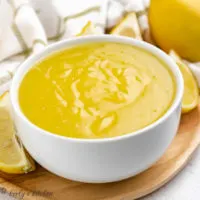
Ingredients
- ¾ cup water, cold
- 2 tablespoons cornstarch
- 1 cup granulated sugar
- ¼ teaspoon salt
- 2 large egg yolks, lightly beaten
- 1 tablespoon lemon zest
- ⅓ cup freshly squeezed lemon juice
- 1 tablespoon unsalted butter, very cold
Instructions
- In a small saucepan over medium heat, combine the cold water, cornstarch, sugar, salt, and egg yolks. Stir vigorously to mix the ingredients and stir occasionally as the filling cooks.¾ cup water2 tablespoons cornstarch1 cup granulated sugar¼ teaspoon salt2 large egg yolks
- After the filling begins to thicken and bubble, stir in the lemon zest and lemon juice. Let boil for approximately 1 minute.1 tablespoon lemon zest⅓ cup freshly squeezed lemon juice
- Remove from heat and stir in butter. Allow filling to cool to room temperature, then strain to remove any scrambled egg yolks.1 tablespoon unsalted butter
- Place in a container and place a piece of plastic wrap over the top touching the lemon curd. Transfer to the refrigerator to cool completely (about 2 hours). Remove the plastic wrap once it cools.
- Use on your favorite breakfast foods or pastries.
- Scroll up and see post for tips, FAQs, storage information, and "How to Make Lemon Curd without Cornstarch."
Suggested Equipment
Notes
- The calories listed are an approximation based on the ingredients in the recipe card and the total amount of 1 tablespoon of lemon curd. Actual calories will vary.

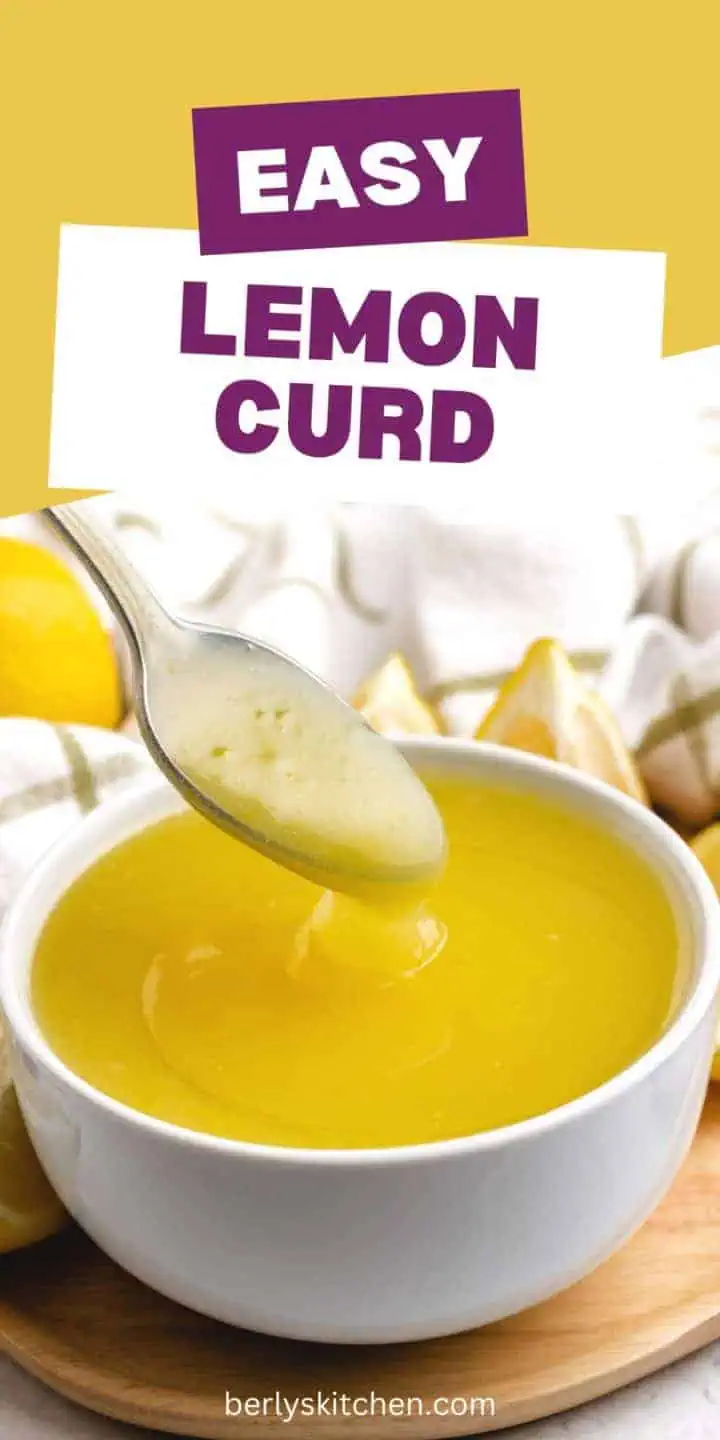
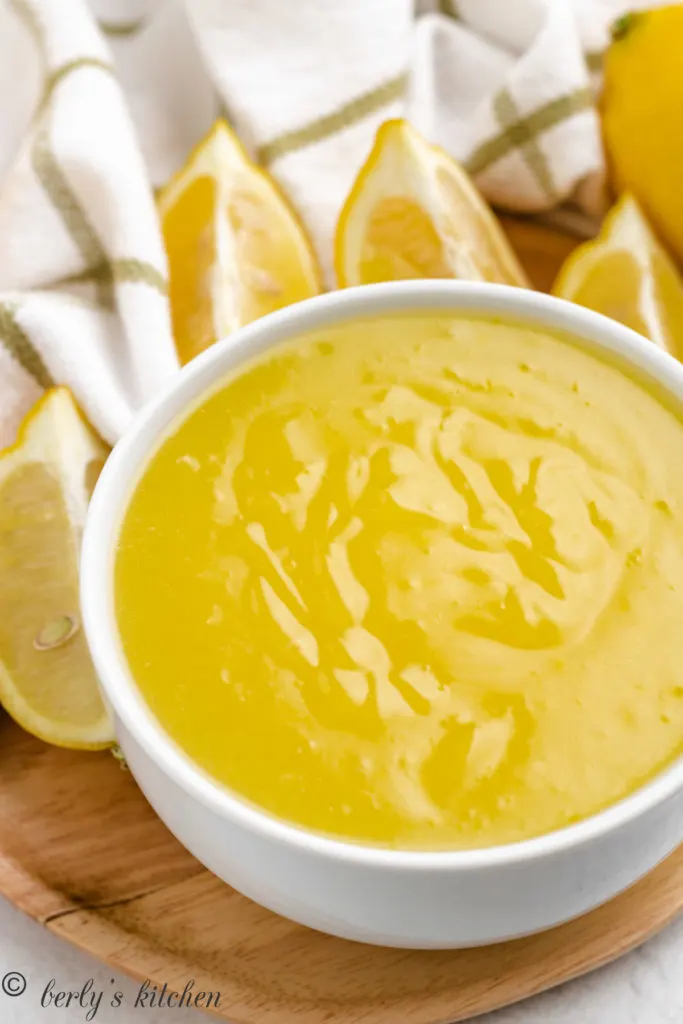
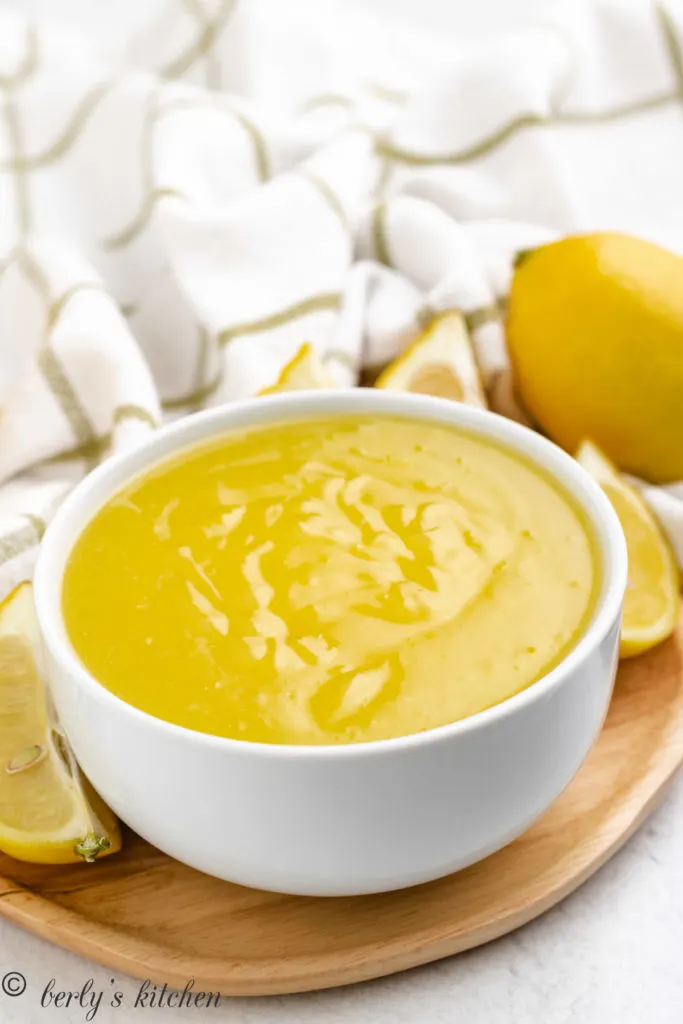
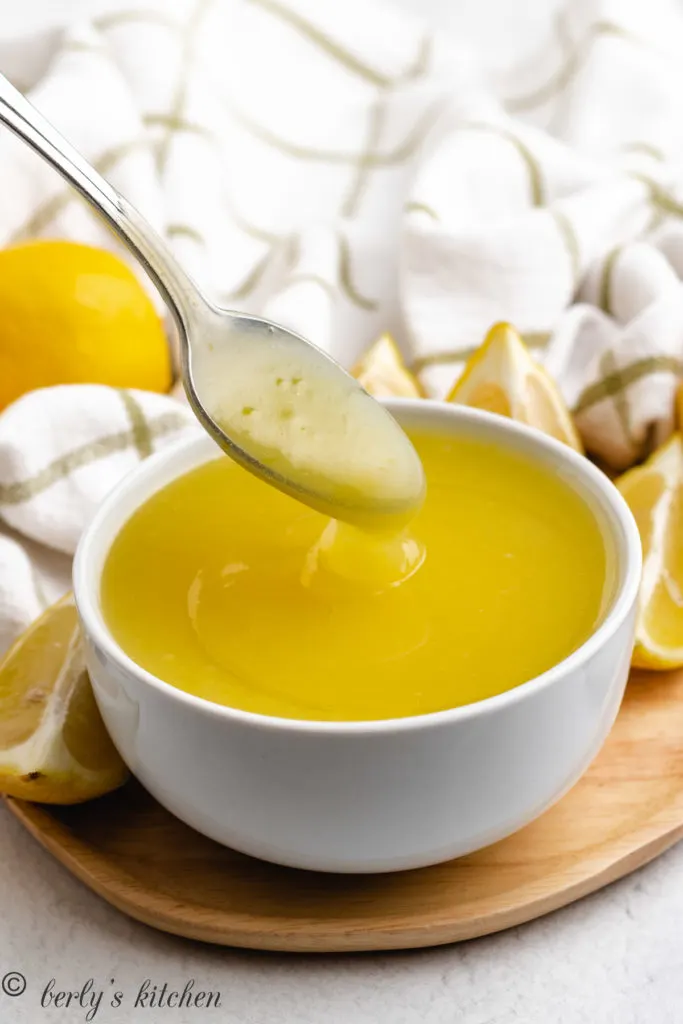


Does this recipe make enough for a 9 inch deep dish pie shell
Good Morning Carol, to answer your question, no the recipe does not make enough pastry filling to fill a 9-inch deep dish pie shell. The recipe only makes about 1-cup of pastry filling. Thank you for asking and have a lovely day 🙂
I use lemon pudding mix to make my merengue pie. I add lemon juice while it’s cooling. While serving, I see the juice at the bottom. Why?
Good Morning Elsa, that’s a good question. It sounds like the meringue is, “weeping.” Moisture from the meringue is being drawn out as the pie bakes and cools and the liquid is pooling in the bottom of the pie. Now, that happens sometimes and there are a few things you can try in order to correct the issue. First, only beat the egg whites until they form soft peaks, not hard peaks. Second, use cream of tartar in the meringue (if you’re not doing so already). Third, try using a different pie filling product. The lemon pudding mix could be causing issues. Last, you could sprinkle a little corn starch or xanthium gum between the meringue and the pie before it bakes. I hope this information helps, have a lovely weekend 🙂
I want to know if this pastry filling is “thicker” than pie filling. I am making a Christmas cookie called a Kiffel and you must use pastry filling (Solo pastry filling). I can never find lemon by Solo, only Apricot and Cherry. Curd is too thin and I must have a “pastry” filling.
Good Morning Cindy, that’s a good question. Unfortunately, no, my recipe is not thicker than a pie filling. However, if you decide to use it, you could incorporate some arrow root or a corn starch slurry during the cooking process. That would thicken it up nicely. I hope this information helps. Have a lovely day 🙂
Have you tried this filling in pastries, such as turnovers, or kolaces? I’m curious if it will bubble up and run out of the pastries while they’re cooking in the oven.
That’s a great question, Mary. Unfortunately, I’ve never tried this filling in a pastry that needs to be baked with the filling inside. My first instinct would be that the filling would probably bubble up and run out of the pastry as it cooks. This filling is better suited for injection after the pastry has been cooked. Kind of like a cream puff filling. With that being said, you could still try it if you like. If you decide to, would you mind coming back and letting us know if it worked for you? I’m really curious about what would happen. Thank you again for your question and we hope you have a lovely weekend, Mary!
This looks really good. Plan on using it as a sauce for an old fashioned hot milk bunt cake.
Thank you, Patricia! I hope it works perfectly for you. I’ve never had an old fashioned hot milk bundt cake. Onward to Google to do some research. Thank you again for commenting and I hope you have a lovely weekend 🙂
My husband loves lemons. He doesn’t like the “fake” fillings found in many grocery store bakery pastries. I’d love to make him a good lemon-filled pastry. This recipe is easy to make and it looks great too! Do you have a pastry recipe you’d recommend?
Thank you for commenting, Kelly! In regards to lemon-filled pastries, you could try the Pepperidge Farms pastry dough. We really loved it and it tastes wonderful. Then you could either use the lemon filling inside a cream puff or use our method and make it a cup. Just substitute the lemon pastry cream for the key lime filling. I hope this helps! Have a great day 🙂
What a lovely filling. I can think of half a dozen ways to use it! It is just tangy enough to be fresh tasty but sweet enough that I was eating it with a spoon! thanks for sharing!
Thank you, Wendy! I am so thrilled you liked the filling and left these compliments. Have a lovely Friday 🙂
This is a great base to keep handy. How does taste and consistency compare to lemon curd?
Thank you, MK! In regards to flavor, I feel like it’s about the same. This might be a little more tart, but that might be the only difference. It’s been awhile since I have eaten lemon curd. Texture wise, it is not as thick as curd, more like the “jelly” in a jelly filled doughnut. I hope that helps and thank you for commenting!